Microbiology Practical: Interpreting ELISA and Western Blot Results
VerifiedAdded on 2022/11/13
|7
|1600
|358
Practical Assignment
AI Summary
This assignment analyzes ELISA and Western blot results for HIV detection, comparing and contrasting the two techniques. It interprets patient results, explaining the significance of positive and negative controls and addressing factors that influence test accuracy, such as the window period and non-IgG factors. The assignment details the differences between HIV infection and AIDS, including diagnosis, treatment, and life expectancy. It also discusses the genetic transfer of HIV, the use of ELISA in various applications beyond infection detection, and the reliability of Western blot techniques. The student provides references to support the analysis.

Running head: PHYSIOLOGY
Topic: PHYSIOLOGY
Name of the Student:
Name of the University:
Author Note:
Topic: PHYSIOLOGY
Name of the Student:
Name of the University:
Author Note:
Paraphrase This Document
Need a fresh take? Get an instant paraphrase of this document with our AI Paraphraser
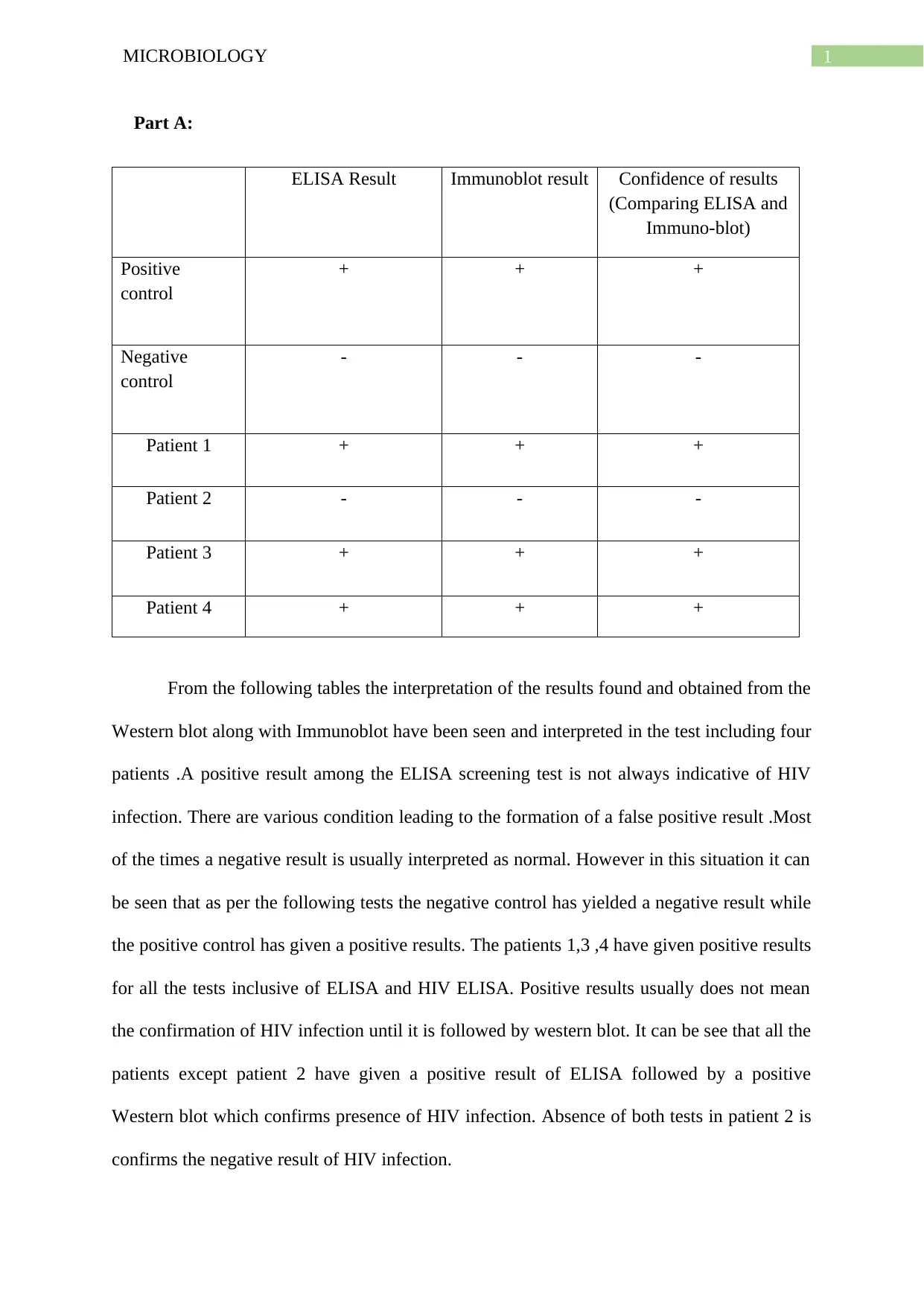
1MICROBIOLOGY
Part A:
ELISA Result Immunoblot result Confidence of results
(Comparing ELISA and
Immuno-blot)
Positive
control
+ + +
Negative
control
- - -
Patient 1 + + +
Patient 2 - - -
Patient 3 + + +
Patient 4 + + +
From the following tables the interpretation of the results found and obtained from the
Western blot along with Immunoblot have been seen and interpreted in the test including four
patients .A positive result among the ELISA screening test is not always indicative of HIV
infection. There are various condition leading to the formation of a false positive result .Most
of the times a negative result is usually interpreted as normal. However in this situation it can
be seen that as per the following tests the negative control has yielded a negative result while
the positive control has given a positive results. The patients 1,3 ,4 have given positive results
for all the tests inclusive of ELISA and HIV ELISA. Positive results usually does not mean
the confirmation of HIV infection until it is followed by western blot. It can be see that all the
patients except patient 2 have given a positive result of ELISA followed by a positive
Western blot which confirms presence of HIV infection. Absence of both tests in patient 2 is
confirms the negative result of HIV infection.
Part A:
ELISA Result Immunoblot result Confidence of results
(Comparing ELISA and
Immuno-blot)
Positive
control
+ + +
Negative
control
- - -
Patient 1 + + +
Patient 2 - - -
Patient 3 + + +
Patient 4 + + +
From the following tables the interpretation of the results found and obtained from the
Western blot along with Immunoblot have been seen and interpreted in the test including four
patients .A positive result among the ELISA screening test is not always indicative of HIV
infection. There are various condition leading to the formation of a false positive result .Most
of the times a negative result is usually interpreted as normal. However in this situation it can
be seen that as per the following tests the negative control has yielded a negative result while
the positive control has given a positive results. The patients 1,3 ,4 have given positive results
for all the tests inclusive of ELISA and HIV ELISA. Positive results usually does not mean
the confirmation of HIV infection until it is followed by western blot. It can be see that all the
patients except patient 2 have given a positive result of ELISA followed by a positive
Western blot which confirms presence of HIV infection. Absence of both tests in patient 2 is
confirms the negative result of HIV infection.
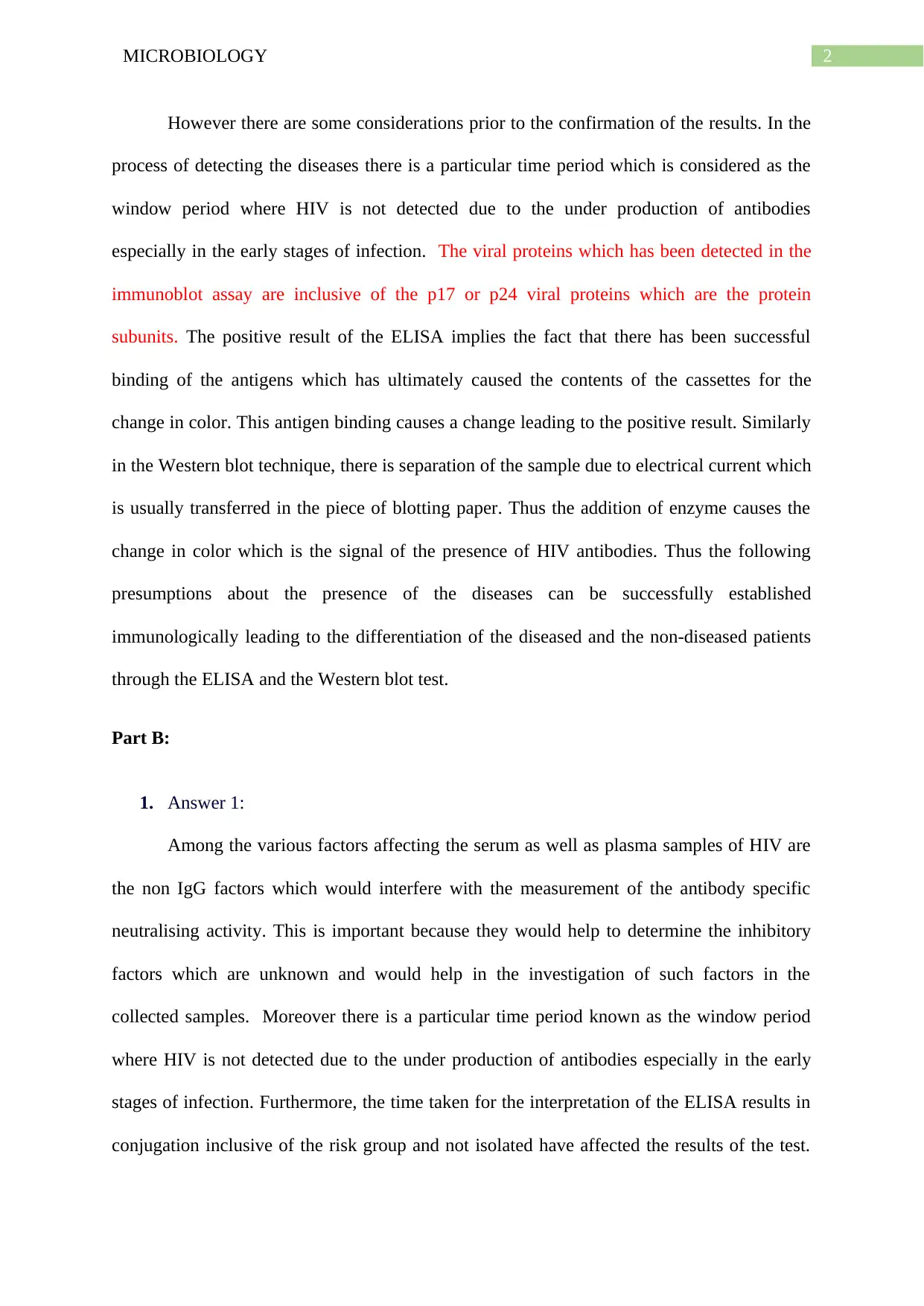
2MICROBIOLOGY
However there are some considerations prior to the confirmation of the results. In the
process of detecting the diseases there is a particular time period which is considered as the
window period where HIV is not detected due to the under production of antibodies
especially in the early stages of infection. The viral proteins which has been detected in the
immunoblot assay are inclusive of the p17 or p24 viral proteins which are the protein
subunits. The positive result of the ELISA implies the fact that there has been successful
binding of the antigens which has ultimately caused the contents of the cassettes for the
change in color. This antigen binding causes a change leading to the positive result. Similarly
in the Western blot technique, there is separation of the sample due to electrical current which
is usually transferred in the piece of blotting paper. Thus the addition of enzyme causes the
change in color which is the signal of the presence of HIV antibodies. Thus the following
presumptions about the presence of the diseases can be successfully established
immunologically leading to the differentiation of the diseased and the non-diseased patients
through the ELISA and the Western blot test.
Part B:
1. Answer 1:
Among the various factors affecting the serum as well as plasma samples of HIV are
the non IgG factors which would interfere with the measurement of the antibody specific
neutralising activity. This is important because they would help to determine the inhibitory
factors which are unknown and would help in the investigation of such factors in the
collected samples. Moreover there is a particular time period known as the window period
where HIV is not detected due to the under production of antibodies especially in the early
stages of infection. Furthermore, the time taken for the interpretation of the ELISA results in
conjugation inclusive of the risk group and not isolated have affected the results of the test.
However there are some considerations prior to the confirmation of the results. In the
process of detecting the diseases there is a particular time period which is considered as the
window period where HIV is not detected due to the under production of antibodies
especially in the early stages of infection. The viral proteins which has been detected in the
immunoblot assay are inclusive of the p17 or p24 viral proteins which are the protein
subunits. The positive result of the ELISA implies the fact that there has been successful
binding of the antigens which has ultimately caused the contents of the cassettes for the
change in color. This antigen binding causes a change leading to the positive result. Similarly
in the Western blot technique, there is separation of the sample due to electrical current which
is usually transferred in the piece of blotting paper. Thus the addition of enzyme causes the
change in color which is the signal of the presence of HIV antibodies. Thus the following
presumptions about the presence of the diseases can be successfully established
immunologically leading to the differentiation of the diseased and the non-diseased patients
through the ELISA and the Western blot test.
Part B:
1. Answer 1:
Among the various factors affecting the serum as well as plasma samples of HIV are
the non IgG factors which would interfere with the measurement of the antibody specific
neutralising activity. This is important because they would help to determine the inhibitory
factors which are unknown and would help in the investigation of such factors in the
collected samples. Moreover there is a particular time period known as the window period
where HIV is not detected due to the under production of antibodies especially in the early
stages of infection. Furthermore, the time taken for the interpretation of the ELISA results in
conjugation inclusive of the risk group and not isolated have affected the results of the test.
⊘ This is a preview!⊘
Do you want full access?
Subscribe today to unlock all pages.

Trusted by 1+ million students worldwide
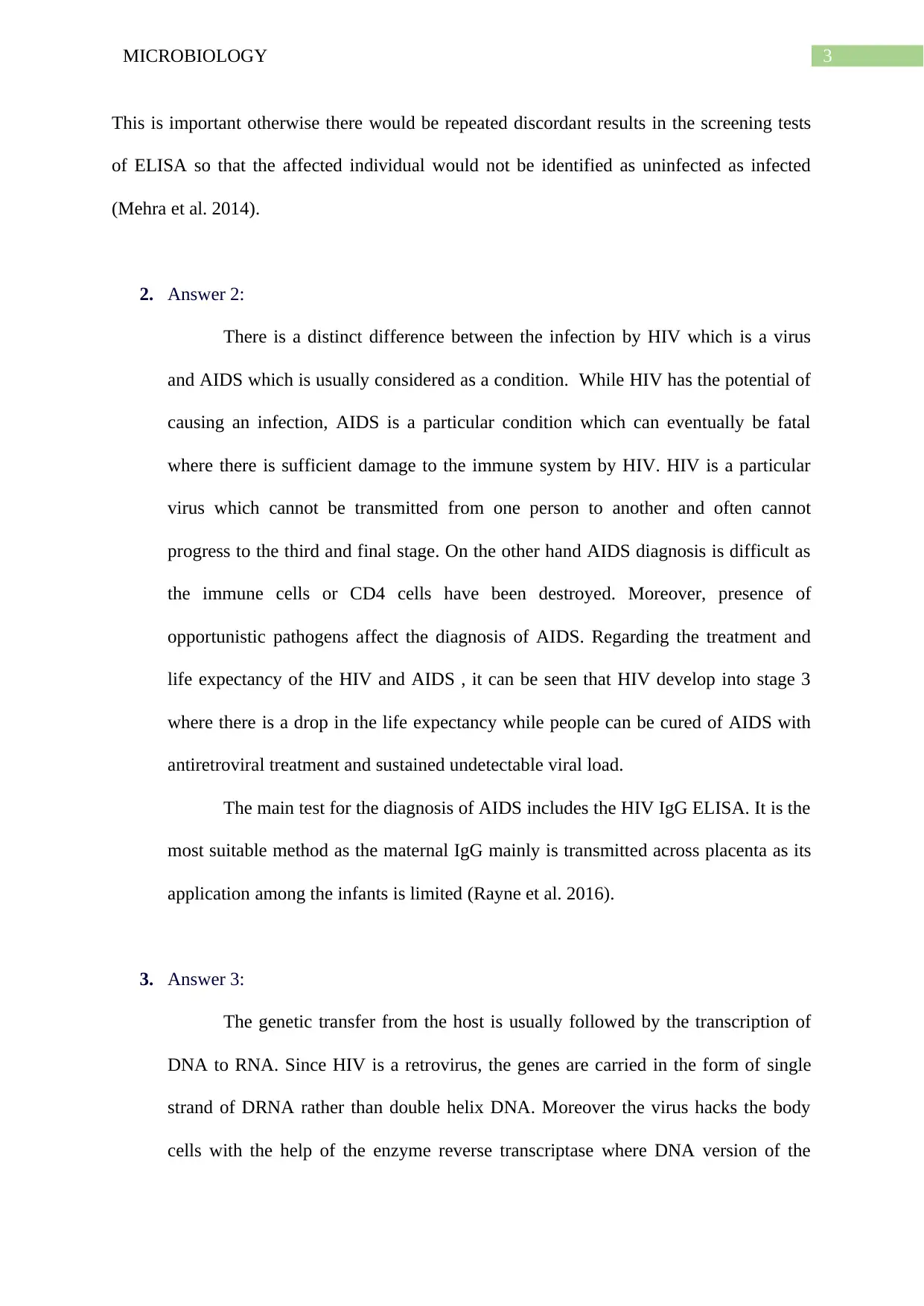
3MICROBIOLOGY
This is important otherwise there would be repeated discordant results in the screening tests
of ELISA so that the affected individual would not be identified as uninfected as infected
(Mehra et al. 2014).
2. Answer 2:
There is a distinct difference between the infection by HIV which is a virus
and AIDS which is usually considered as a condition. While HIV has the potential of
causing an infection, AIDS is a particular condition which can eventually be fatal
where there is sufficient damage to the immune system by HIV. HIV is a particular
virus which cannot be transmitted from one person to another and often cannot
progress to the third and final stage. On the other hand AIDS diagnosis is difficult as
the immune cells or CD4 cells have been destroyed. Moreover, presence of
opportunistic pathogens affect the diagnosis of AIDS. Regarding the treatment and
life expectancy of the HIV and AIDS , it can be seen that HIV develop into stage 3
where there is a drop in the life expectancy while people can be cured of AIDS with
antiretroviral treatment and sustained undetectable viral load.
The main test for the diagnosis of AIDS includes the HIV IgG ELISA. It is the
most suitable method as the maternal IgG mainly is transmitted across placenta as its
application among the infants is limited (Rayne et al. 2016).
3. Answer 3:
The genetic transfer from the host is usually followed by the transcription of
DNA to RNA. Since HIV is a retrovirus, the genes are carried in the form of single
strand of DRNA rather than double helix DNA. Moreover the virus hacks the body
cells with the help of the enzyme reverse transcriptase where DNA version of the
This is important otherwise there would be repeated discordant results in the screening tests
of ELISA so that the affected individual would not be identified as uninfected as infected
(Mehra et al. 2014).
2. Answer 2:
There is a distinct difference between the infection by HIV which is a virus
and AIDS which is usually considered as a condition. While HIV has the potential of
causing an infection, AIDS is a particular condition which can eventually be fatal
where there is sufficient damage to the immune system by HIV. HIV is a particular
virus which cannot be transmitted from one person to another and often cannot
progress to the third and final stage. On the other hand AIDS diagnosis is difficult as
the immune cells or CD4 cells have been destroyed. Moreover, presence of
opportunistic pathogens affect the diagnosis of AIDS. Regarding the treatment and
life expectancy of the HIV and AIDS , it can be seen that HIV develop into stage 3
where there is a drop in the life expectancy while people can be cured of AIDS with
antiretroviral treatment and sustained undetectable viral load.
The main test for the diagnosis of AIDS includes the HIV IgG ELISA. It is the
most suitable method as the maternal IgG mainly is transmitted across placenta as its
application among the infants is limited (Rayne et al. 2016).
3. Answer 3:
The genetic transfer from the host is usually followed by the transcription of
DNA to RNA. Since HIV is a retrovirus, the genes are carried in the form of single
strand of DRNA rather than double helix DNA. Moreover the virus hacks the body
cells with the help of the enzyme reverse transcriptase where DNA version of the
Paraphrase This Document
Need a fresh take? Get an instant paraphrase of this document with our AI Paraphraser
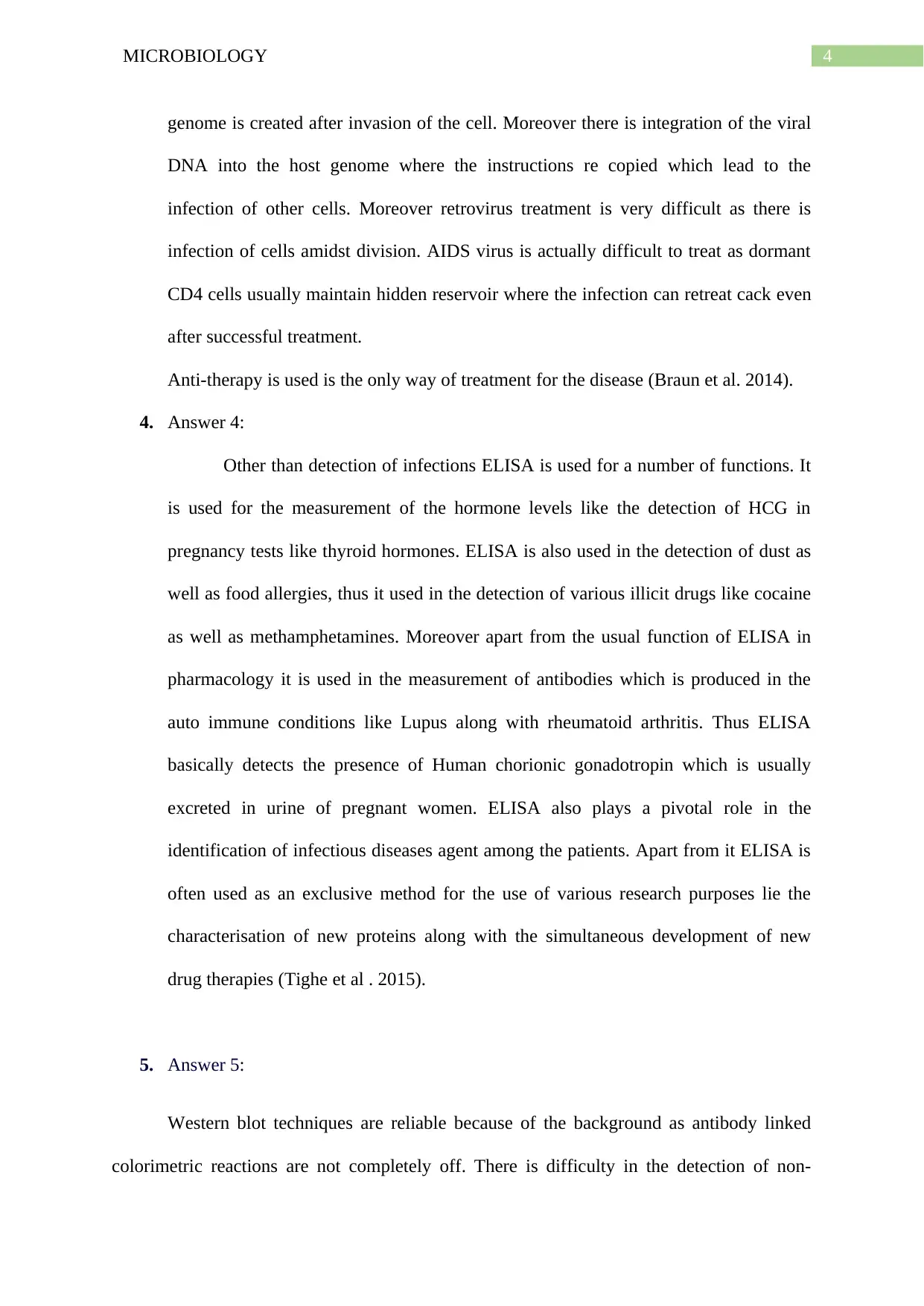
4MICROBIOLOGY
genome is created after invasion of the cell. Moreover there is integration of the viral
DNA into the host genome where the instructions re copied which lead to the
infection of other cells. Moreover retrovirus treatment is very difficult as there is
infection of cells amidst division. AIDS virus is actually difficult to treat as dormant
CD4 cells usually maintain hidden reservoir where the infection can retreat cack even
after successful treatment.
Anti-therapy is used is the only way of treatment for the disease (Braun et al. 2014).
4. Answer 4:
Other than detection of infections ELISA is used for a number of functions. It
is used for the measurement of the hormone levels like the detection of HCG in
pregnancy tests like thyroid hormones. ELISA is also used in the detection of dust as
well as food allergies, thus it used in the detection of various illicit drugs like cocaine
as well as methamphetamines. Moreover apart from the usual function of ELISA in
pharmacology it is used in the measurement of antibodies which is produced in the
auto immune conditions like Lupus along with rheumatoid arthritis. Thus ELISA
basically detects the presence of Human chorionic gonadotropin which is usually
excreted in urine of pregnant women. ELISA also plays a pivotal role in the
identification of infectious diseases agent among the patients. Apart from it ELISA is
often used as an exclusive method for the use of various research purposes lie the
characterisation of new proteins along with the simultaneous development of new
drug therapies (Tighe et al . 2015).
5. Answer 5:
Western blot techniques are reliable because of the background as antibody linked
colorimetric reactions are not completely off. There is difficulty in the detection of non-
genome is created after invasion of the cell. Moreover there is integration of the viral
DNA into the host genome where the instructions re copied which lead to the
infection of other cells. Moreover retrovirus treatment is very difficult as there is
infection of cells amidst division. AIDS virus is actually difficult to treat as dormant
CD4 cells usually maintain hidden reservoir where the infection can retreat cack even
after successful treatment.
Anti-therapy is used is the only way of treatment for the disease (Braun et al. 2014).
4. Answer 4:
Other than detection of infections ELISA is used for a number of functions. It
is used for the measurement of the hormone levels like the detection of HCG in
pregnancy tests like thyroid hormones. ELISA is also used in the detection of dust as
well as food allergies, thus it used in the detection of various illicit drugs like cocaine
as well as methamphetamines. Moreover apart from the usual function of ELISA in
pharmacology it is used in the measurement of antibodies which is produced in the
auto immune conditions like Lupus along with rheumatoid arthritis. Thus ELISA
basically detects the presence of Human chorionic gonadotropin which is usually
excreted in urine of pregnant women. ELISA also plays a pivotal role in the
identification of infectious diseases agent among the patients. Apart from it ELISA is
often used as an exclusive method for the use of various research purposes lie the
characterisation of new proteins along with the simultaneous development of new
drug therapies (Tighe et al . 2015).
5. Answer 5:
Western blot techniques are reliable because of the background as antibody linked
colorimetric reactions are not completely off. There is difficulty in the detection of non-

5MICROBIOLOGY
specificity in the ELISA assay. Moreover in the process of Western Blotting, there is
separation of proteins prior to the process of antibody linked detection. Furthermore in
addition to the above advantages, HIV tests gives a further confident signal than the ELISA
as it would be helpful in the detection of the low false positive tests. Another reason behind
the preference of the Western blot is that the various antigens are usually attached to the
membranes including the nitrocellulose membranes and the reactions which would be
performed on the surface of the membrane (Baltazar et al. 2014).
specificity in the ELISA assay. Moreover in the process of Western Blotting, there is
separation of proteins prior to the process of antibody linked detection. Furthermore in
addition to the above advantages, HIV tests gives a further confident signal than the ELISA
as it would be helpful in the detection of the low false positive tests. Another reason behind
the preference of the Western blot is that the various antigens are usually attached to the
membranes including the nitrocellulose membranes and the reactions which would be
performed on the surface of the membrane (Baltazar et al. 2014).
⊘ This is a preview!⊘
Do you want full access?
Subscribe today to unlock all pages.

Trusted by 1+ million students worldwide
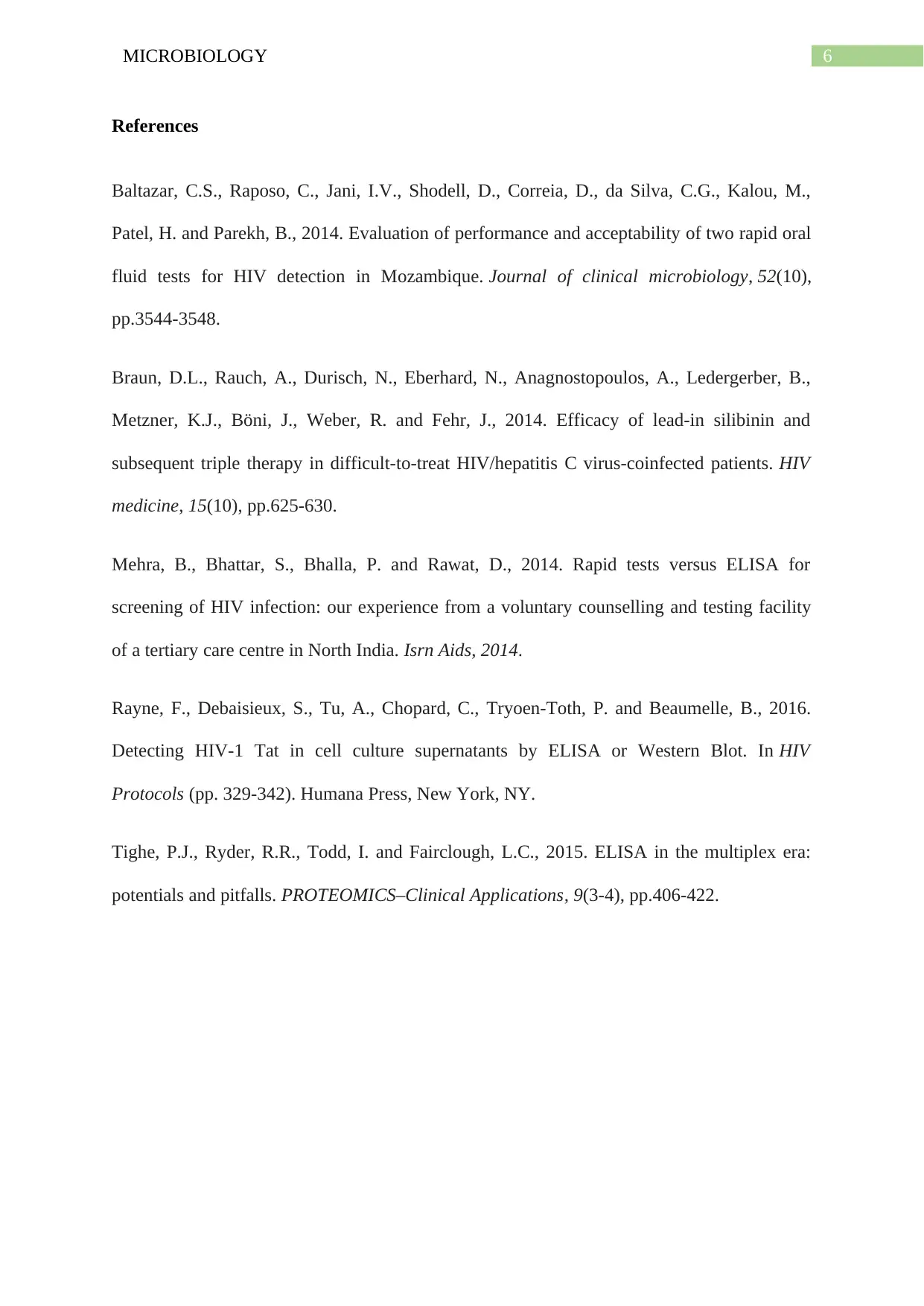
6MICROBIOLOGY
References
Baltazar, C.S., Raposo, C., Jani, I.V., Shodell, D., Correia, D., da Silva, C.G., Kalou, M.,
Patel, H. and Parekh, B., 2014. Evaluation of performance and acceptability of two rapid oral
fluid tests for HIV detection in Mozambique. Journal of clinical microbiology, 52(10),
pp.3544-3548.
Braun, D.L., Rauch, A., Durisch, N., Eberhard, N., Anagnostopoulos, A., Ledergerber, B.,
Metzner, K.J., Böni, J., Weber, R. and Fehr, J., 2014. Efficacy of lead‐in silibinin and
subsequent triple therapy in difficult‐to‐treat HIV/hepatitis C virus‐coinfected patients. HIV
medicine, 15(10), pp.625-630.
Mehra, B., Bhattar, S., Bhalla, P. and Rawat, D., 2014. Rapid tests versus ELISA for
screening of HIV infection: our experience from a voluntary counselling and testing facility
of a tertiary care centre in North India. Isrn Aids, 2014.
Rayne, F., Debaisieux, S., Tu, A., Chopard, C., Tryoen-Toth, P. and Beaumelle, B., 2016.
Detecting HIV-1 Tat in cell culture supernatants by ELISA or Western Blot. In HIV
Protocols (pp. 329-342). Humana Press, New York, NY.
Tighe, P.J., Ryder, R.R., Todd, I. and Fairclough, L.C., 2015. ELISA in the multiplex era:
potentials and pitfalls. PROTEOMICS–Clinical Applications, 9(3-4), pp.406-422.
References
Baltazar, C.S., Raposo, C., Jani, I.V., Shodell, D., Correia, D., da Silva, C.G., Kalou, M.,
Patel, H. and Parekh, B., 2014. Evaluation of performance and acceptability of two rapid oral
fluid tests for HIV detection in Mozambique. Journal of clinical microbiology, 52(10),
pp.3544-3548.
Braun, D.L., Rauch, A., Durisch, N., Eberhard, N., Anagnostopoulos, A., Ledergerber, B.,
Metzner, K.J., Böni, J., Weber, R. and Fehr, J., 2014. Efficacy of lead‐in silibinin and
subsequent triple therapy in difficult‐to‐treat HIV/hepatitis C virus‐coinfected patients. HIV
medicine, 15(10), pp.625-630.
Mehra, B., Bhattar, S., Bhalla, P. and Rawat, D., 2014. Rapid tests versus ELISA for
screening of HIV infection: our experience from a voluntary counselling and testing facility
of a tertiary care centre in North India. Isrn Aids, 2014.
Rayne, F., Debaisieux, S., Tu, A., Chopard, C., Tryoen-Toth, P. and Beaumelle, B., 2016.
Detecting HIV-1 Tat in cell culture supernatants by ELISA or Western Blot. In HIV
Protocols (pp. 329-342). Humana Press, New York, NY.
Tighe, P.J., Ryder, R.R., Todd, I. and Fairclough, L.C., 2015. ELISA in the multiplex era:
potentials and pitfalls. PROTEOMICS–Clinical Applications, 9(3-4), pp.406-422.
1 out of 7
Related Documents
Your All-in-One AI-Powered Toolkit for Academic Success.
+13062052269
info@desklib.com
Available 24*7 on WhatsApp / Email
![[object Object]](/_next/static/media/star-bottom.7253800d.svg)
Unlock your academic potential
Copyright © 2020–2025 A2Z Services. All Rights Reserved. Developed and managed by ZUCOL.





